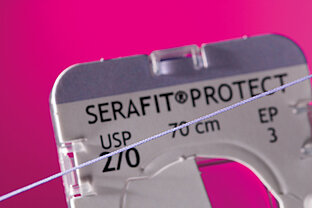Distinguishing features
Origin of the materials
A distinction is made between suture materials of natural origin and those of synthetic origin. Suture materials of natural origin include silk. The other group consists of synthetically manufactured polymers, such as polyamide, polyolefin and polyester sutures. These also include absorbable polymers made from polyglycolic acid.
Absorbability
The half-life is defined as the period of time in which the tensile strength of a suture falls to half of its original value. A further important criterion is the dissolution time. This term describes the time required until complete macroscopic dissolution of the suture in the tissues. The half-life and the dissolution time are influenced by many factors, however, such as suture thickness, tissue type, infection status of the wound and, not least, by the patient's general health.






